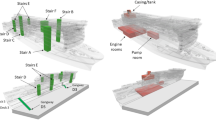Abstract
On the 19 June 2001, a Thames passenger/tour boat underwent several evacuation trials. This work was conducted in order to collect data for the validation of marine-based computer models. The trials involved 111 participants who were distributed throughout the vessel. The boat had two decks and two points of exit from the lower deck placed on either side of the craft, forward and aft. The boat had a twin set of staircases towards the rear of the craft, just forward of the rear exits. maritimeEXODUS was used to simulate the full-scale evacuation trials conducted. The simulation times generated were compared against the original results and categorised according to the exit point availability. The predictions closely approximate the original results, differing by an average of 6.6% across the comparisons, with numerous qualitative similarities between the predictions and experimental results. The maritimeEXODUS evacuation model was then used to examine the evacuation procedure currently employed on the vessel. This was found to have potential to produce long evacuation times. maritimeEXODUS was used to suggest modifications to the mustering procedures. These theoretical results suggest that it is possible to significantly reduce evacuation times.
Similar content being viewed by others
References
Private Communication with J.Hall of the Marine and Coast Guard Agency, 03/09/01.
S. Gwynne, E.R. Galea, P.J. Lawrence, M. Owen, and L. Filippidis “A Review of the Methodologies used in the Computer Simulation of Evacuation from the Built Environment,” Building and Environment, vol. 34, 1999, pp. 741–749.
S. Gwynne, E.R. Galea, M. Owen, and L. Filippidis, “A Systematic Comparison of Model Predictions Produced by the buildingEXODUS Evacuation Model and the Tsukuba Pavilion Evacuation Data,” Applied Fire Science, vol. 7,no. 3, 1998, pp. 235–266.
E.R. Galea, M. Owen, and P. Lawrence, “Computer Modelling of Human Behavior in Aircraft Fire Accidents,” Toxicology, vol. 115,nos. 1–3, 1996, pp. 63–78.
E.R. Galea, “Safer by Design: Using Computer Simulation to Predict the Evacuation Performance of Passenger Ships,” in Proc. IMarE Conf. vol 112,no. 2, Safety of Large Passenger Ships, ISBN 1–902536–31–2, London, 2000, pp. 23–32.
E.R. Galea, L. Filippidis, P.J. Lawrence, and M. Owen, “An Evacuation Demonstration of a Typical High Speed Craft Using the EXODUS Evacuation Model,” Report prepared by FSEG for RINA, Ref G/DG/1998/000116, London, 1998.
E.R. Galea, P.J. Lawrence, and M. Owen, “Predicting the Evacuation Performance of Mass Transport Vehicles Using Computer Models,” in Proc, Fire Safety On Ships, IMAS London, 1994, pp. 239–251.
E.R. Galea, S. Gwynne, D. Blackshields, P. Lawrence, and L. Filippidis, “Predicting the Evacuation Performance of Passenger Ships Using Computer Simulation,” in Proceedings of the 9th International Fire Science Conference interflam 2001, Interscience Communications, ISBN 0953231275, Edinburgh, 2001, pp. 853–864.
S. Gwynne, “The Introduction of Adaptive Social Decision-Making in the Mathematical Modelling of Egress Behavior,” Ph.D. Thesis, University of Greenwich, London, 2000.
D.A. Purser, “Toxicity Assessment of Combustion Products,” The SFPE, Handbook of Fire Protection Engineering (2nd ed.), P.J. Dilenno, C.L. Beyer, R.L.P. Custer, W.D. Walton, J.M.W. Watts, D. Drysdale, and J.R. Hall (Eds.), National Fire Protection Association, Quincy, MA, 1996, pp. (2–85)–(2–146).
R.D. Peacock, G.P. Forney, P. Reneke, R. Portier, and W.W. Jones, “CFAST, The Consolidated Model of Fire Growth and Smoke Transport,” NIST Tech Note 1299, U.S. Dept. of Commerce, Technology Administration, NIST, 1993.
S. Gwynne, E.R. Galea, C. Lyster, and I. Glen, “Simulating the Evacuation Trials of a Thames Pleasure Craft Using the maritimeEXODUS Evacuation Model.” Preliminary Confidential Report for the UK Marine and Coastguard Agency, FSEG University of Greenwich, MEX/thames/sg/0801/rev1.0, 1st August 2001.
S. Gwynne, E.R. Galea, C. Lyster, and I. Glen, “Simulating the Evacuation Trials of a Thames Pleasure Craft Using the maritimeEXODUS Evacuation Model.” Final Confidential Report for the UK Marine and Coastguard Agency, FSEG University of Greenwich, MEX/thames/sg/0901/rev3.0, 15th September 2001.
HMSO, The Building Regulations 1991—Approved Document B, section B1, HMSO Publications, London.
Author information
Authors and Affiliations
Rights and permissions
About this article
Cite this article
Gwynne, S., Galea, E., Lyster, C. et al. Analysing the Evacuation Procedures Employed on a Thames Passenger Boat Using the maritimeEXODUS Evacuation Model. Fire Technology 39, 225–246 (2003). https://doi.org/10.1023/A:1024189414319
Issue Date:
DOI: https://doi.org/10.1023/A:1024189414319




